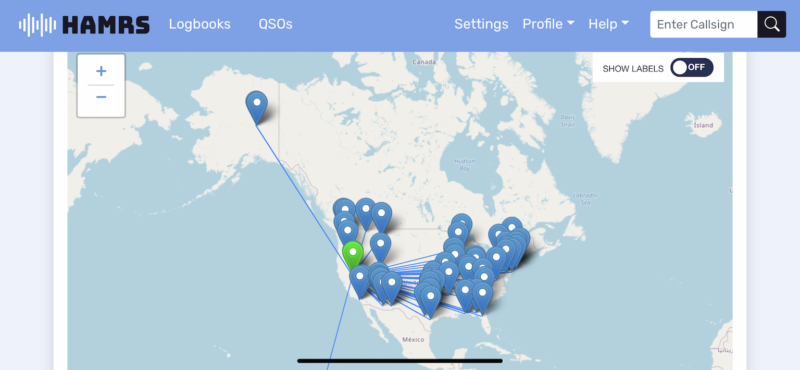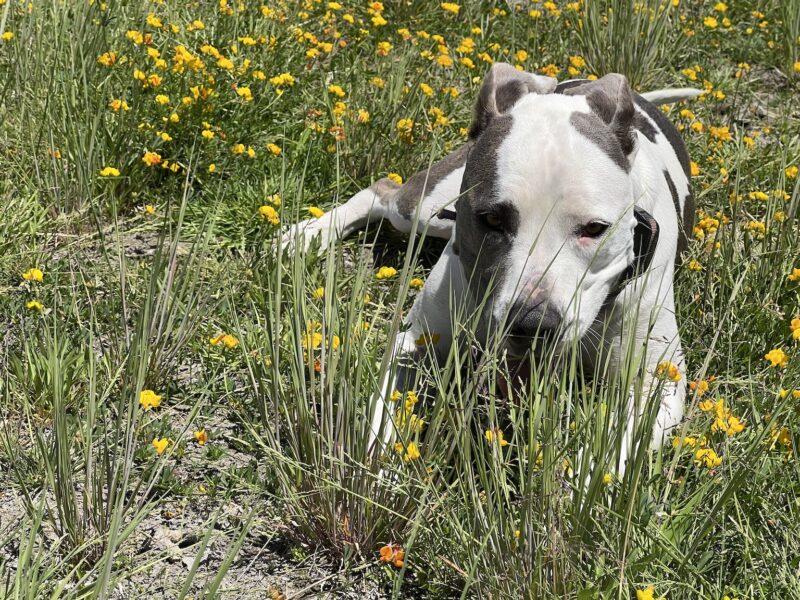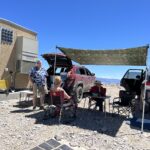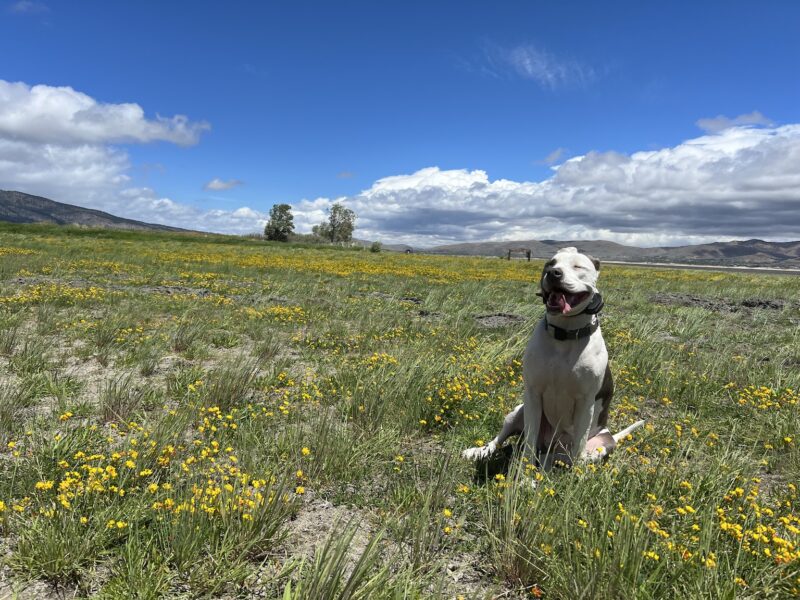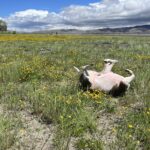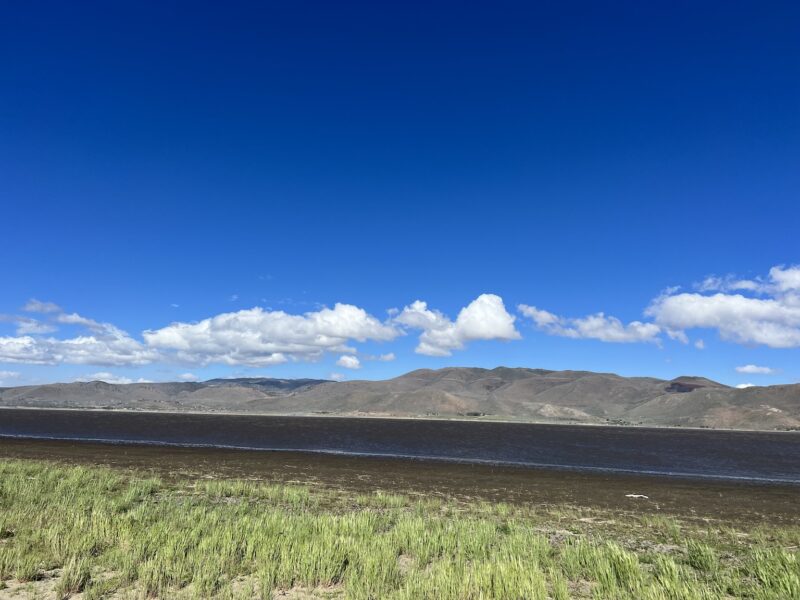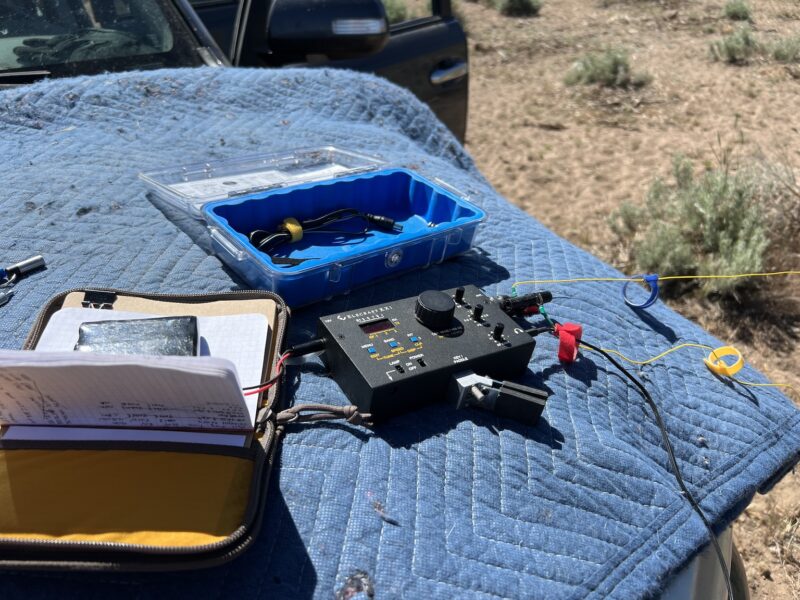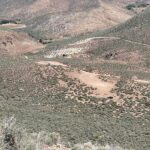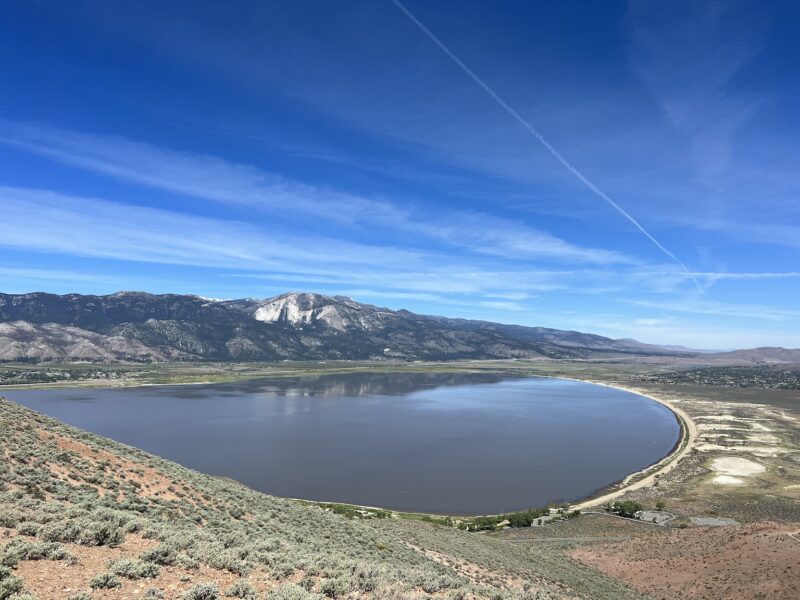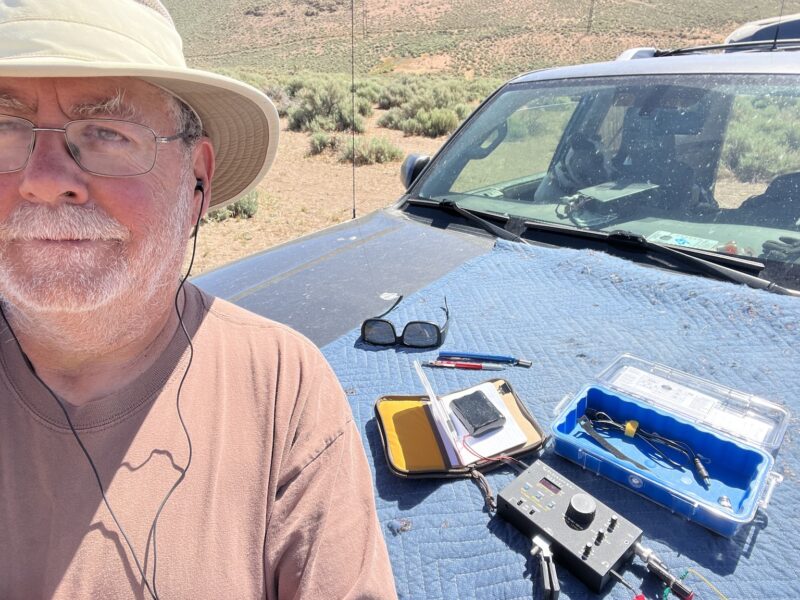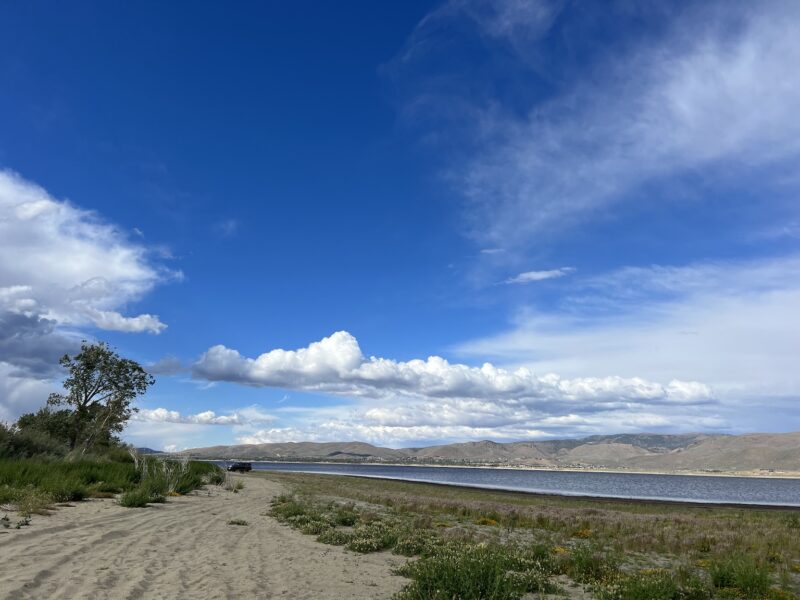
After returning from a fast trip to Summit Lake for field work, I wanted some recreational outdoor time for the weekend. The Girl and I like Washoe Lake State Park, in particular the west side that is undeveloped and less used. There is a great place to setup a radio station and activate the park for Parks on the Air. Plus we can walk the west shoreline without encountering a lot of other people.
Saturday was cold and cloudy for the middle of June. Nonplussed, after working a good part of the morning, I put a few things into the rig and The Girl and I headed north for some outdoor time. On the way out of town, I stopped at McDonald’s for a fish sandwich and then at C-A-L Ranch to pick up a few tent stakes. I am moving away from the plastic stakes, which break easily in the desert, to the aluminum stakes that are more hardy.
It is a short trip to the lake and we were there in short order. I parked the rig in the lee of a sand dune on the west side. The Girl and I got out and went for a 20-minute walk. That allows her to burn off some energy and provides me the opportunity to move my blood around.
On return to the rig, I affixed a new antenna to the 7m SOTAbeams mast and then deployed the guy lines for the mast. I would normally strap the mast to a support, but at the lake site none was available.
The new antenna is a 40m off-center fed dipole. I checked it with the antenna analyzer at is is resonant on 40m, 20m, 15m, and 10m. So it is a four-band antenna and those are four useful bands. And, for those bands, no additional matching transformation is needed.
I used the Discovery TX-500 and the PA-500 radio and amplifier for the activation. There was no heard activity on 40m and 10m was not open, so I tried 15m. After spotting myself and calling for five minutes, nothing was heard. So I re-spotted myself on 20m and started calling.
That resulted in a number of calling stations. I worked them as they came in, sometimes singletons and sometimes in groups of two or three. I had my activation by about 1630h local time and took more calls until about 1645h, logging 16 stations. The 20m band was quite noisy, popping and sizzling with sunspot activity. QSB (fading) was moderate with some of the weaker stations requiring a few repetitions to make the exchange.
When I quit, I was cold. The wind had stolen my heat. I retrieved the packable anorak from the rig and put it over my hoodie. I then tore down the station and stowed everything. Then I got The Girl out for another walk and we called it a day.
On the way home I stopped at Francisco’s Mexican Restaurant, a favorite place, and bought Tacos de Asada. It was a lovely, spicy meal, and the hot chow did me good.
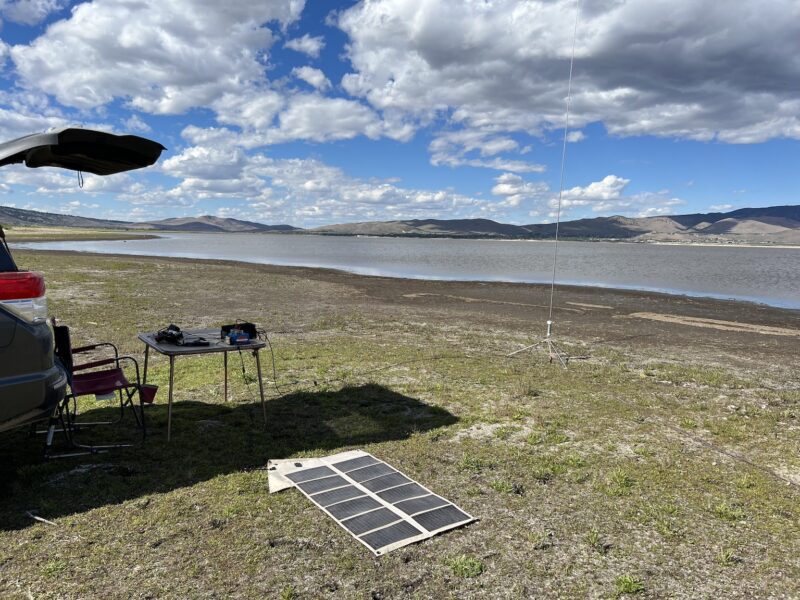
Sunday morning I had in mind to return to Washoe Lake SP and do some testing of another old antenna, the Wolf River Coils vertical. Because of the way I operate, it does not get a lot of use. I typically change frequencies often, hunting other stations. But for running a frequency, the use of a resonant antenna is more efficient. Plus the antenna is simply and quickly setup and tuned. And, because I intended to activate the park, a single band would be fine for this mode of operation.
So, again we drove up to the park and to the operating point. There I found a man, Nelton, who had bogged his pickup truck in a mud hole. It was not buried, but he could not get enough traction to roll out. We attempted to pull it out with what he had for a tow strap (not much), but it was not strong enough for even the slightest pressure. As I prepared to help dig him out his son arrived in his pickup with a tow strap. So, off The Girl and I went to continue our day.
I picked my spot, on a mudflat where I expected good ground conductivity (but did not get stuck). I parked the rig, got The Girl out, and we walked. She played, threatened to run out into the lake (too muddy), and then threatened to roll in a dead carp (no go). On the way back she chased me and we played a little.
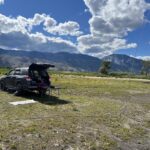
I turned on the radio and listened on 7.2835MHz for the 40m Noontime Net. It was not quite 1300h local and I heard nothing. I checked the Internet for solar conditions and it looked like we had a bit of X-ray influx that disturbed the Ionosphere and frequencies below 14MHz were blacked out. So I returned to the antenna and adjusted it for the 20m band. I got a good match on 20m.
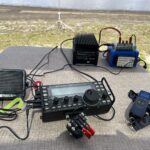
I chased a few more activators and then decided I was having no fun with phone. So I found an unused frequency in the CW portion of the band and spotted myself on the POTA website. I adjusted my logging software (HAMRS on my iPhone) for the new frequency and started calling.
Again I worked a steady stream of stations who returned my general call. A few were calling pretty slowly (10-12wpm), so I slowed down. The lazy way is to keep the keyer set at your speed and add spacing between characters. The good operator approach is to turn down the keyer speed to match the other station. With the Elecraft radios, that is easy to do. So, that is what I did.
After fishing the 20m hole dry, I switched to the 17m band. That required a trip to the antenna, with the analyzer, and an adjustment of the radiator length (a telescoping stainless steel whip). That took only a few minutes and then I was back at the station.
The 17m band generated quite a few calls in response to my general call and spot. I worked those stations one by one.
Once I start working a station, particularly one that is weak to me, I ignore other callers as I send the part of the call I heard and request a fill. It usually does not take long for the other caller(s) to figure out I will work the current station before I accept another call and they shut up. After I work the station and send TU (thank you) and 73 (best wishes), I send “DE AG7TX POTA AR” (which means AG7TX is calling POTA and standing by) and wait. If I hear nothing, then I start the general call again, “CQ CQ CQ POTA DE AG7TX AG7TX POTA AR” and listen for a few seconds.
When 17m went dry, I switched to 15m after seeing a couple of spots for the 12m band on the POTA website. Again I adjusted the antenna and returned to my station to call. After a few attempts, I heard nothing. About that time a text message from my buddy Dick came in that he had not noticed me on the park. I responded that I would return to 20m to take his call.
Which I then did.
After I re-spotted myself on the POTA website and started calling, Dick came in LOUD. I worked him and put him in my log. I then worked several more stations, including several in California.
I almost never hear California station on 20m. I think those I worked were far enough south that I was in the first “skip” zone for the 20m band. In any event, I was happy to work them.
When no more calls came, I signed off “QRT DE AG7TX SK” and listened for a moment. I often pick up a straggler or two after signing off. If I am called, I answer. But, hearing nothing, I turned off the radio and put away the station.
I got The Girl out and we went for another walk. She was very playful, attacking my boots and zooming around. She again threatened to run into the muddy water and roll on the dead fish. I laughed and called her in, which resulted in more attacks on my (new) boots.
Back at the rig, we hopped inside and warmed up a bit. It was a cool June day in western Nevada. As we headed home, I reflected on my weekend. I was satisfied that I made progress on several tasks, including some work. I decided to order a pizza for supper (and several more meals). It was a good day and a good weekend. I am grateful.
Again, I learned things over the weekend.
- Always take an extra cover in the rig. I do get cold.
- Put the makings for a hot drink (coffee, tea, cocoa) in the rig and the material to heat water and make a hot drink.
- Put a couple of dehydrated meals in the rig and the material to make hot water to rehydrate the food. Hot chow is a good thing when cold.
- I am not certain that a band-limited antenna is right for me. It probably depends on the particular operation and whether (or not) there is a contest ongoing.
- In light of the above, it makes sense to have access to a couple of antennas in the rig. This is not generally an issue for me.
- I need to study the tools available for measuring and predicting propagation. I am learning, but I think there is more to learn and some additional tools that will inform when a particular band (or bands) is open.
- There is no reason to waste time calling on a closed band. Over the last few outings, I tried 15m several times without success. Although I was experimenting (testing), my time would be better spent working bands where I can make contacts.
- The WRC antenna is a solid performer when running a frequency. It is not band agile and is not appropriate for that application. But for a POTA (or SOTA) activator who will run a frequency, it is easily tunable to the desired band/frequency and is reasonably efficient.
- I want to experiment with the WRC antenna some more. It would be very interesting to take it to the coast and operate from the beach. Hmmm… a camping trip???
- My Morse Code skills are improving.
- I am easily frustrated operating phone, particularly when trying to call an activator.
Over the weekend, I logged 62 contacts at Washoe Lake State Park. Again, it was a good weekend.
